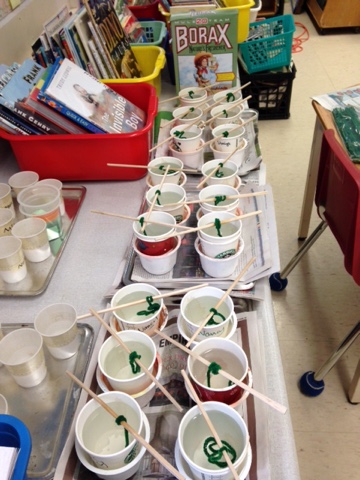News for January 29
This week the students did a variety of activities from writing a research book about a centipede we found in our class, to mastering the use of the homophones "there, their, they're" to memorizing the poem "Saluation to the Dawn".
In math, the children reviewed how to read and write time using analog and digit clocks. After reviewing the parts of an analog clock, the children practised telling and showing time on the hour (:00) half-hour (:30), quarter after the hour (:15) and quarter to the hour (:45). The children realized that the minute hand position is easy to read and show but the hour hand is very tricky.
The class learned the cursive letters j, o, r, s and t. We've learned 15 out of 26 lowercase cursive letters so far.
In science, the class did a choral reading activity to learn about the six types of simple machines (levers, inclined planes, wheel and axle, pullies, screws and wedges). The students also chose an everyday object to learn more about and figure out which type of simple machine(s) that object uses to work. For example, our class will be learning more about the history of the clothespin, the can opener and unicycle. Everything in our world has a story!
In writing, the children found a centipede on the floor in the classroom, so we dedided to learn a bit more about "Lucky the centipede" before we let him go in the basement of the school. Each student wrote a fact about centipedes and we made a class book compiling these facts. It turns out that Lucky is a common house centipede but there are 2,800 different kinds of centipedes on earth. Did you know that centipedes live for 3 to 7 years and are insectivores that hunt and eat insects? Did you know that the Amazonian centipede is 30 centimetres long and can eat small lizards and catch a bat in mid-flight?
Students wrote first person narrative poems about the foil sculptures they made last week. These are now on display in the hallway outside of our classroom. We also discussed nursery rhymes and how many poems the children already knew.
In reading, the class practised their reading comprehension skills by reading the non-fiction text about animal survival and answering questions to prove their understanding of the information. In our guided reading book club groups, the students completed what they could of a story outline graphic organizer and were then responsible for finishing their books, so that they are ready for the final book activity next week.
On Wednesday, our school had a common classroom clean up time. We had Scott, a helper from Starbucks come to help our class. The children scrubbed, wiped, swept and picked up to make out class nice and clean. Even the principal, Mrs. Farrelly came to visit our class!
In spelling, the students worked very hard to learn the spelling and proper usage of the homophones, here/hear and the most difficult set of homophones in English, there/their/they're.
We finished the wonderful chapter book, "Stone Fox" this week. Most of the children had accurately predicted the ending of the story, BUT there was an unexpected twist at the end, that had the students feeling the amazing power of words, and left everyone feeling happy for the main character and incredibly sad at the same time. Many students, (and their teacher) were in tears. Oh, the power of a good story well told!
All this month, the children have been practising each day, how to read 7-digit numbers (up to a million). I've been trying to help the students understand just how large an amount one million is...so I made a challenge to the class to figure out how to show a million of something. We read aloud the book, "One Million Dots" and learned that if you made a dot every second of every day (no breaks) it would take a million seconds to do that. However, one million seconds is actually equal to 11 and a half days! Wow! How could we possibly show that? The class had lots of ideas...but we settled on each student making a sheet of 1,000 dots. So, 1,000 dots made by 20 people, makes 20,000 dots...only 980,000 dots to go...(we decided to use the photocopier next week to help us with this problem).
The class began to plan for "The Room 204 Interview Show" this week. We started with listing who in the school they wanted to know more about, then we listed questions to ask the interview guests. The children randomly chose interviewer partners and created large posters to be used at the beginning of the episode of the show for which they are responsible.
The students used the posters that they created using the lines from the ancient Sanskrit poem, "Saluation to the Dawn", to help them learn the words to memorize the poem. We even made a video of the students reciting the poem. (This video may be seen in the February 7th posting.)
Books read aloud this week:
Stone Fox by John Reynolds Gardiner (chapter book - now finished)
A Million Dots by Andrew Clements
My FIrst Mother Goose retold by Rosemary Wells























